|
By Jerry Wilkinson [Comments as well as
additional documentation, photos, etc. can be sent
to:
The following is a comprehensive discussion of the two Works Progress
Administration (WPA) built concrete hurricane/refuge schools in
the
Upper Florida Keys. These buildings were not related to the FERA
sponsored Red Cross houses in any manner; albeit, both were steel
reinforced concrete construction. One specific difference is that fresh
water was used in the school houses. The documentation is from material
that I
have collected for decades, but there are gaps of logic which I hope to
correct in years to come. Some difficulty will be because of the time
gaps
and another will be following documents which were written by federal
agencies versus
those which are from the Monroe County School Board. These documents
will be peppered with newspaper articles with their name in italics.
As much as possible for this subject I excerpt the actual entries from
the documents. These should be recognized by the use of quotation and
ellipse marks. I do assume that the reader is vaguely familiar with
the
area. If not, please Click Here
for a simple map. I can be contacted at
the email tab at the end of the article. I do include material that may
only be supporting to the subject and I will as much as possible
proceed chronologically.jerry@keyshistory.org or 305.852.1620] -
PROLOGUE -
The 1923
School
Board minutes indicate approval and award of a contract to South
Florida Construction and Engineering Company to build two early
masonry schools
in the Upper Keys for a 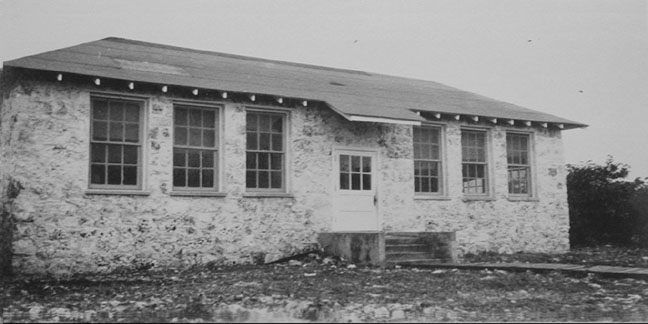 total of
$5,260.00. total of
$5,260.00. The top photo to the right is the Rock Harbor School as it appeared in 1927 and is the coral rock portion of the present-day Moose Lodge at about MM 98 in the median. Harold Albury was the teacher. - - The lower photo to the right is of the Metacombie, this is the spelling in the minutes, of the Matecumbe School. This school was totally destroyed by the 1935 Hurricane, but was in the location of the presentday Cheeca Lodge. Charles Albury was the teacher and 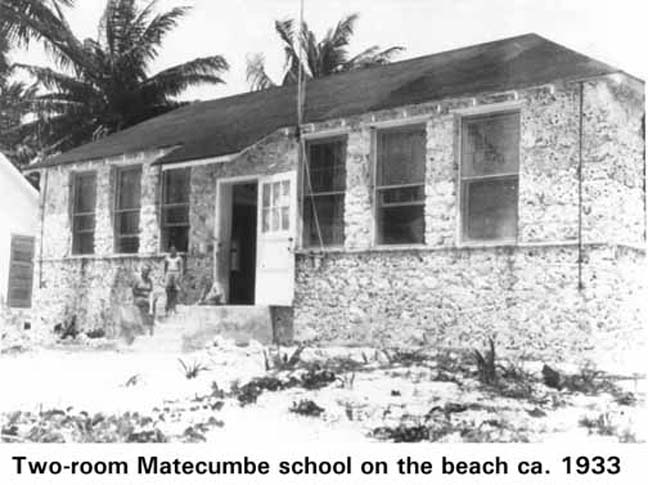 Ferran Pinder
was
added in 1932. For
a reference, in the September 22, 1932 School Board minutes, Mr. Albury
reported 46
students attending 'Metacombie' School. It will be a long time after
the hurricane before they have that many students again. Ferran Pinder
was
added in 1932. For
a reference, in the September 22, 1932 School Board minutes, Mr. Albury
reported 46
students attending 'Metacombie' School. It will be a long time after
the hurricane before they have that many students again.There was a third Upper Keys school in operation before the 1935 Hurricane. The School Board minutes of September 12, 1933, approved the leasing of a building from Mr. and Mrs. Roger (Sarah) Albury for $15.00 per month, but this was considered too high; therefore, it was rented month-to-month with a clause the agreement could be terminated with one month's notice. This building was in front of their home and near the highway State Road 4-A. The school building is shown about in the center of the photo after the 1935 Hurricane two photos later. Today, only the wooden two-story post office at the photo's center-right remains for reference. The school would have been to the right (south) of the entrance gate to Old Settler's Park which was the Roger and Sarah Albury residence at about MM-92. 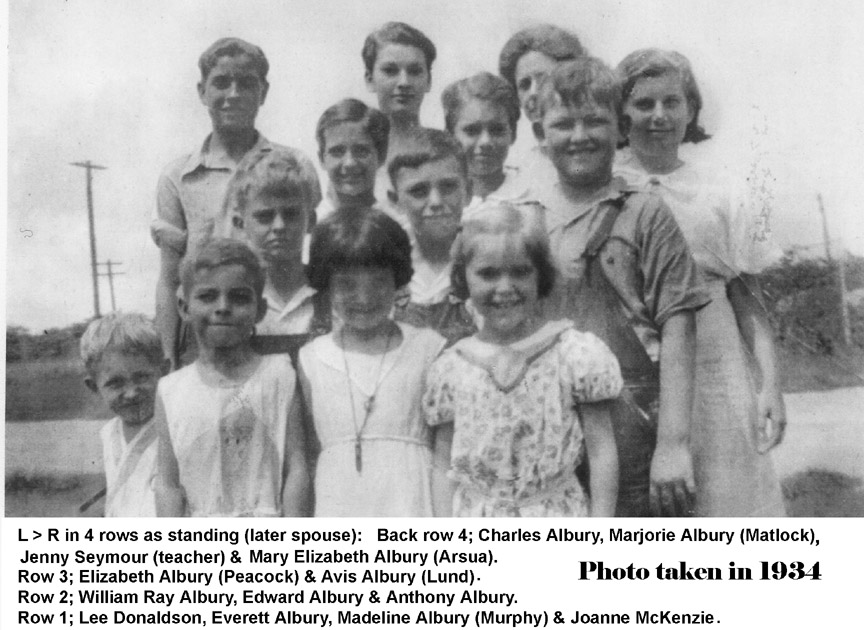 Ms. Jennie Seymour was the teacher. Everett Albury
remembers about 12
students in the school before the hurricane. A photo taken in
1934 is at the right and the teacher, Ms. Seymour, can barely be seen
to our right on the back row. This building survived the 1935 Hurricane
and was used until the Tavernier Hurricane-Refuge school was opened. Ms. Jennie Seymour was the teacher. Everett Albury
remembers about 12
students in the school before the hurricane. A photo taken in
1934 is at the right and the teacher, Ms. Seymour, can barely be seen
to our right on the back row. This building survived the 1935 Hurricane
and was used until the Tavernier Hurricane-Refuge school was opened.The following emergency situation occurred at a very inopportune time - mainly during the Great Depression. On one hand we see Monroe County trying to get help for the scarcely populated part of the county outside of its county seat at Key West. We find a hint of this in "History Notes" in the Monroe County School newsletter "Tropic Topics" stating, "On June 4, 1934, the Board passed a resolution to apply for federal aid to construct and equip school buildings on certain Florida Keys, exclusive of Key West." In July 1934 the county declared bankruptcy. On the other hand we find an almost destitute county when July 4, 1934 newspapers throughout the state announced that Key West and Monroe County were bankrupt, 75% were unemployed and 'people were starving.' Yet we find a glimmer of hope from a copy of a letter from J.L. Graham, Florida Director of School Building wrote in a letter to Mrs. Hilda G. Floyd of Islamorada dated August 22, 1935, "... I believe that if you will contact the County Superintendent of Monroe County and your Regional Works Progress Administrator at Key West and proceed as Mr. Watson and the enclosed letter to the county superintendent suggests, that you will be able to secure the needed school at Islamorada at an early date. "If you do not need more than a four room frame school building we can furnish a plan for you. If you want us to furnish a plan write us stating direction the school will face and the number of class rooms needed. We shall be happy to help you in every possible way...." In reality, the only help there was was using funds from President Franklin D. Roosevelt's newly created (1933) New Deal work program under the leadership of Harry Hopkins, but the entire country was scrambling for their share. The country, the states and the counties were all to some degree crippled by the stock marker collapse, then the Great Depression. Mother nature was about to deal Monroe County, especially the Upper Keys, a crippling blow - no pub intended. -
THE 1935 HURRICANE -
The above established three schools in the Upper Keys were functional
before the hurricane on September 2, 1935 and were prepared to open
following the Labor Day weekend.
Four days later on September 6, 1935 we read from the Monroe County
Board of
Public Instruction (School Board), from here on referr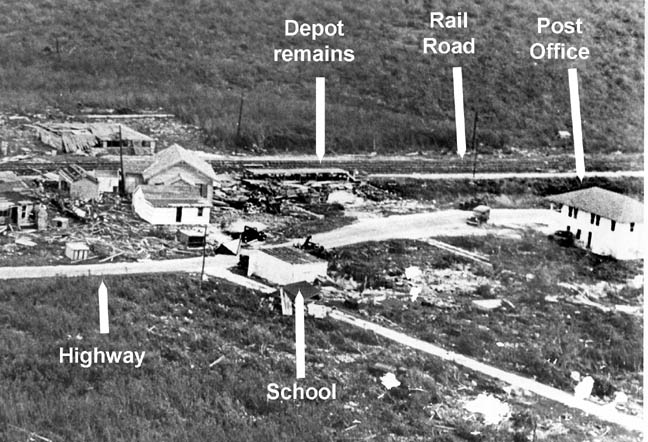 ed to as
MCBPI, "... It was decided to make application through the District WPA
office for six new schools for the Keys as follows: Big Pine Key, 1
one-teacher school; Marathon 2 one-teacher schools; Rock
Harbor 1 one-teacher school; Tavernier 1 two-teacher school; and
Matecumbe 1 four-teacher school.... [Note: The Tavernier School
building is shown to the right, was repaired and continued education
until the later concrete school was built. - JW] ed to as
MCBPI, "... It was decided to make application through the District WPA
office for six new schools for the Keys as follows: Big Pine Key, 1
one-teacher school; Marathon 2 one-teacher schools; Rock
Harbor 1 one-teacher school; Tavernier 1 two-teacher school; and
Matecumbe 1 four-teacher school.... [Note: The Tavernier School
building is shown to the right, was repaired and continued education
until the later concrete school was built. - JW]"Superintendent reported that the Labor Day hurricane had completely destroyed the Matecumbe school and had damaged all the rest of the schools on the Keys to a greater or lessor extent. It was decided to delay the opening of the Keys schools for two weeks...Clarence H. Pierce." My comment to this is, none could have been damaged more! Clarence H. Pierce signed all future MCBPI minutes unless noted otherwise. Another disclaimer is that I do not have a complete set of MCBPI minutes; therefore, there will be unknown gaps in this article. Some of the following incidents are not directly related to the two concrete school buildings, but I believe are related to the use, support and operation there of. Not only had the hurricane destroyed the Matecumbe school, but had destroyed 40 miles of railroad track in the Upper Keys - meaning no rail service. The Florida East Coast Railway went into bankruptcy in 1932; therefore, there was serious doubt that it would rebuild the Key West Extension. The automobile ferry landing in the Upper Keys was totally destroyed along with one of the three ferryboats, and all the highway south of Snake Creek (MM 85.7). All points south of Snake Creek were only accessible by airplane or boat. Following the events chronologically, the next related MCBPI minutes are on September 26, 1935, "... The Superintendent reported the school building at Tavernier as not ready. This referred to the small Roger Albury building that suffered some water and wind damage, but could be made habitable within a short time. A side issue occurred in Key West the first week of December 1935 when 1,200 WPA workers went on strike and the WPA suspended all projects. The two school projects had not yet received approval; therefore, were not involved. Then on "December 19, 1935 ... The superintendent reported a visit from Preston Pinder of Matecumbe that the Matecumbe school bus had been blown amongst some trees by the September hurricane and the top had been badly damaged. The Superintendent is to ascertain cost of salvage and repair...." Using my documentation this ended the year of 1935. -
1936 -
January 2, 1936, "... The
superintendent reported a personal inspection of the Matecumbe school
bus. The damage consisted of the top and seals completely
destroyed, the headlight and battery missing, the body scratched and
dented and the engine in need of overhaul. Contacted Mr. Green to place
the bus on the ferry and send to Key West...."The first documentation that I find specifically about the future concrete WPA school buildings is a Key West Citizen article dated April 10, 1936, "... The plan submitted by [Rep. J. Mark] Wilcox and adopted by the Works Progress Administration contemplates the construction of hurricane proof community houses along the lower east coast and in the Lake Okeechobee and the keys region. The buildings will be of sufficient size to house the entire population in the area served by each. They will be used for school, church and general civic purposes and during the hurricane season will be used as houses of refuge in which people of the area may escape the dangers of high wind and water. Each building will be equipped with standard weather recording instruments and will be used as stations for collection and distribution of accurate weather information. "Wilcox explained today that the complete program calls for construction of at least twenty such buildings, but only nine could be built this year. The estimated value of the nine to be constructed this year will be $300,000, he said...." The Miami Herald version also points out "... That the shelters must be sponsored by the localities,..." The best that I can determine is that three were attempted, one at Bay Haven, Florida, but only the two in the Keys completed. A series of newspaper articles beginning on May 15, 1936 appeared throughout Florida stating in general that all of the Florida PWA projects may be in jeopardy because of a supreme court case requiring approval by a vote by freeholders since most Florida cities now have the maximum indebtedness allowed by law. Obviously, this did not happen as all Florida projects continued. The Miami Tribune on May 22, 1936, carried, "STORM SHELTER SURVEY ENDED - Preliminary WPA survey of the sites for proposed storm shelters among the Florida Keys was completed yesterday, O.A. Sandquest, WPA Director, announced. "Ray Sheldon, WPA engineer went here from Jacksonville to make the surveys, returned there yesterday with all the data collected. It will be compiled there and sent on to WPA headquarters in Washington. "Construction of the shelters by WPA already has been voted by congress but funds are not now available for construction. The bill was sponsored by Congressman Mark Wilcox." Ray Sheldon was the assistant camp director of the FERA World War I veteran's project to build a highway bridge from Lower Matecumbe Key to No Name Key eliminating the vehicle ferry boats. The '35 Cane' destroyed all of the project other than the eight remaining concrete bridge piers bayside at MM 73 and small island recently named, Veterans Key. An element of the July 30, 1936, MCBPI minutes states, "... A letter enclosing one set of WPA Form 301 was received from the Acting WPA Administrator Goodman with reference to the installation of Storm Shutters on the school buildings. An estimate prepared by Mr. Ray W. Sheldon showed a total cost of materials of $800.00 of which the sponsor, or School Board, would be expected to contribute $193.80. Also the sponsor would have to haul, fit, hang and paint the shutters.... It was decided to defer authorization for sponsoring the project." An element of the August 6, 1936 MCBPI minutes states, "... Upon recommendation of the School Supervisor Preston Pinder at Matecumbe, Mr. [Eddie] Sweeting's building was rented for a school at $8.40 a month. Ferran Pinder was appointed teacher, and Sheldon Stone, bus driver." It appears that there was no school at Islamorada from September 1935 to this approval. It should remembered that there were few families returning to Islamorada until about this time. Most were at Miami or Key West awaiting houses to be built. Only the house of Leo and Agnes Johnson in Islamorada was rebuilt after the hurricane and they had no children. I understand a few Islamorada families were at Tavernier which did have the small Roger Albury school facility. According to the late Bernard Russell and Jimmy Woods, the first returning Islamorada adults lived in a tent on the beach while building wooden houses of some sort. I am not certain when the first Red Cross/FERA concre 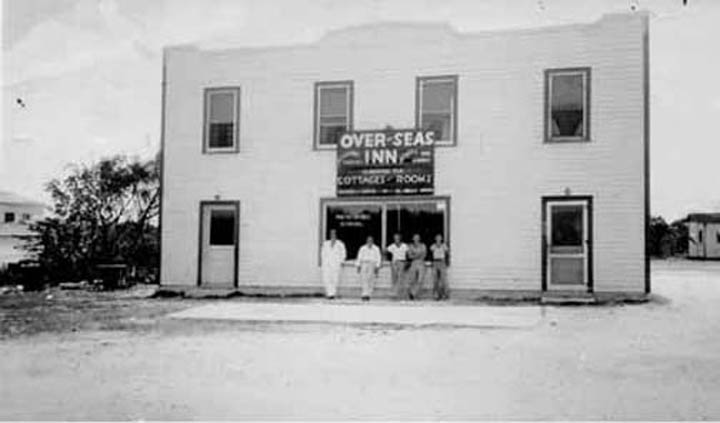 te house was
signed over for occupancy. It is
obvious that some local residents returned to work quickly as Eddie
Sweeting had
the building shown to
the right ready for occupancy on August 1936. te house was
signed over for occupancy. It is
obvious that some local residents returned to work quickly as Eddie
Sweeting had
the building shown to
the right ready for occupancy on August 1936.The Federal Emergency Relief Administration (FERA) was a sister New Deal agency to the WPA, but FERA provided relief for non-public entities. In the Upper Keys it constructed 29 concrete houses, two wooden houses and two wooden business buildings using the American Red Cross as its contracting agent. The Red Cross had nothing to do with two WPA storm/refuge schools. Evidently, with a separate agreement the FERA agreed to allow and provide all material to Islamorada resident, contractor and grocery man, Eddie Sweeting, to build a two-story wooden building to replace the house and residence the Sweeting family lost in the hurricane. Eddie Sweeting was to provide all the labor and tools with FERA providing only building materials. Therefore, Matecumbe also had a small school facility soon after the hurricane. A Miami Herald article of August 16, 1936, stated that "... Williams said the shelters to be built at Matecumbe and Tavernier will be constructed by federal emergency relief administration [FERA] at a camp south of Miami in charge of Lieut. Cmdt. William H. Green...." The above reference to FERA was incorrect. It was FERA who were to build the houses on private property using the American Red Cross as its contractor. FERA could use its funds for private properties, the WPA could not! The alphabet soup agencies created under FDR's New Deal were many including the CCC, FCA. FCC, FHA, FSA, NLRB, PWA, REA, SEC, SSB, TVA, FERA and WPA. The WPA was created in 1935 to provide work for needy persons on public works programs. FERA was created in 1933 to cooperate with states in relieving hardships cause by unemployment and droughts - to droughts were added other acts of God such as hurricanes. On August 22, 1936, Aubrey Williams, Deputy WPA Administrator, Washington D.C. sent the following telegram to E.A. Pynchon, Florida Administrator, WPA correcting the Miami Herald article: "Retel twentieth regarding storm shelter project STOP Newspaper announcements of FERA grant in error STOP Request that WPA applications be submitted for construction of two hurricane proof shelters one at Matecumbe and one at Tavernier STOP Exemptions absolutely necessary to permit operation of projects will be granted STOP [Governor] Holts letter does not give special exemption for these projects but merely refers to general authority granted [the] state administrator by Administrator Order [number] thirty three." For those who remember telegrams, they used "STOP" instead of the ordinary punctuation "period." Returning to the Matecumbe school situation, the September 3, 1936, MCBPI minutes has the following entry: "An inquiry was received from Mr. Preston Pinder relative to the Board's desire to sell the school property on the beach, The Secretary was to inform Mr. Pinder that it had not thought of selling this property at the present time, and also ask him what price might be expected in case it was decided to sell...." The former school that was destroyed was located on the beach of the Atlantic Ocean along side of the church which was along side of the cemetery. Another item from the MCBPI September 10, 1936 minutes: "... Mr. Preston Pinder headed a committee of three from Matecumbe to discuss the school situation for Matecumbe for the present year. The entire Sweeting building with the exception of half the second floor was rented on a month to month basis for $40.00 per month. Mr. Sheldon Stone was appointed the bus driver at a salary of $90.00 per month. Miss. Virginia Shine [of Key West] was appointed a second teacher for the school...." Three items for the Upper Keys Schools appeared in the MCBPI September 17, 1936 meeting: [1] "... Mr. Preston Pinder, School Trustee of Matecumbe, wrote that he has secured room and board for an additional teacher at the Matecumbe School for $15.00 per month. [2] "Mr. John A. Russell wrote from Islamorada that he had offered a site for the storm refuge school, but that the Works Progress Administration had not yet accepted. He added that in case this site were accepted, he will expect the School Board to deed back to him the property which had been donated for the school in 1935. [3] "Mr. Harold Russell of Rock Harbor requested new seats for the Rock Harbor School, and also additional library books. Library books were ordered purchased, but the buying of the seats were deferred, pending information as to the number of children for the year...." Next in time is a very faded WPA form dated "9/21/36" which includes both school buildings from which I excerpt cost data the best that I can read it from line 14: Labor = $19,967. Superintendence = $4,620. Subtotal = $24,587 Material, equipment, etc. = $15,478. $8,200. Total = $40,045. $48,245. In addition to the above $8,200 for a total dollar cost of $48,245 for the two school buildings, the MCBPI was to supply the real estate property. The MCBPI had the old Matecumbe school beach property but no property for the Tavernier School. Line 10 states that work can start 21 days after approval and requires 4.5 months for completion. Please indulge me in passing on the unrelated following teacher salary schedule established at the October 8, 1936 meeting which may be of interest to some and an abbreviated portion follows: White teachers Negro teachers BASE SALARY BASE SALARY High School Grad. = $80.00 - $40.00 Normal Graduate = $75.00 - $50.00 College Graduate = $100.00 - $60.00 FOR EXPERIENCE H. S. Grad. with second grade certif. = $2.00 - $1.00 H.S. Grad. with first/primary certif. = $3.00 - $2.00 Normal Graduate = $4.00 - $3.00 College Graduate = $5.00 - $4.00 Increase for experience limited to five years Salaries of all bus drivers were set at $90.00 per month. Time is passing and it is now slightly over a year since the hurricane. In my collection is a telegram dated October 24, 1936 probably a reply to Rep. Wilcox. It is to Rep. Wilcox from W.A. McMullen, Assistant WPA Administrator stating in telegraph lingo, "Presidential letter approving Keys storm shelters not yet received STOP Expect early part of next week[.]" I admit that following the money trail is a shortcoming of my documents. An interesting item since the old beach property is available, in the MCBPI November 5, 1936 meeting is, "... Mr. John A. Russell requested that the property at Matecumbe which was deeded to the School Board by the Russell Estate for school purposes be deeded back to the estate since the property of Mr. Matherson [sic] had been approved by the WPA. No action was taken on this request, pending satisfactory arrangements for the property with Mr. Matherson [sic]...."  All indications were that education at the three schools were progressing without serious problem. The MCBPI minutes of November 12, 1936 states, "... Mr. Chas C. Albury's salary was increased $25.00 per month for additional work with the senior high school pupils at Tavernier." None of the three schools were accredited for the 12th grade; however, when possible they always tried to prepare students for graduation at other schools, usually at Homestead or Key West. See photo at the right. At this same time, Ferran Pinder was teaching at the Matecumbe school confined to the Sweeting building and awaiting completion of the WPA concrete school. See photo at the right and below 'Prof' Albury. Harold Russell teaching at the old coral rock Rock Harbor school and I don't have a photo of Harold. The aforementioned property comment became clearer at the November 27, 1936 meeting, "... Deeds conveying the ocean front school property on Matecumbe to Mr. [Hugh M. Matheson] Matherson and the school site adjoining the proposed park at Matecumbe to the Russell estate, prepared by Mr. Allen B Cleare, Jr. were executed and ord 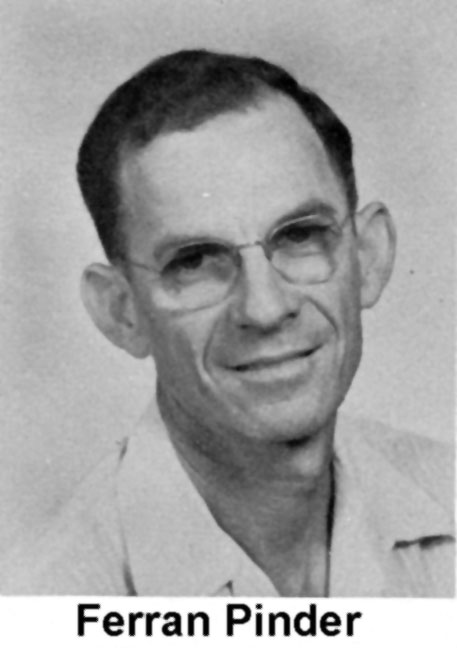 ered held for
delivery until such time as the work on the storm refuge school houses
was authorized to begin...." Hugh Matheson owned the property where the
school and the hurricane memorial were to be built which he traded for
the
southwest ocean front property where the Cheeca Lodge presently is.
They traded bayfront property for oceanfront property. ered held for
delivery until such time as the work on the storm refuge school houses
was authorized to begin...." Hugh Matheson owned the property where the
school and the hurricane memorial were to be built which he traded for
the
southwest ocean front property where the Cheeca Lodge presently is.
They traded bayfront property for oceanfront property.The year 1936 was closed out for the MCBPI at its December 14th meeting when the MCBPI approved the canceling of the 1935 and 1936 delinquent taxes of the Florida East Coast Railway. The debt of these school taxes were delaying the transfer of the railroad right-of-way to the state for building of the new Overseas Highway and work on the highway needed to begin. Part of this right-of-way passed through the former Matheson property. This transaction provided the land for the construction of the Islamorada Hurricane/Refuge School as well as the school. Property for the Tavernier School was also in the process to be purchased. Note at this time, the upper end of Upper Matecumbe Key was referred to as Islamorada, the Islamorada FEC depot was there, but the lower end was referred to as Matecumbe, the Matecumbe FEC depot was there. The WPA ended 1936 with a December 15th Washington, D.C. letter stating that the "... construction of two storm shelters houses on the Florida Keys... have priority over other WPA activities in that district. " For Upper Matecumbe Key this meant that the schools had priority over the construction of the Florida Keys Memorial - known now as the hurricane monument. To go to that web page Please Click Here. -
1937 -
Alonzo
Bliss sent a letter to Frank Ingram, State WPA Administrator, dated
August 25, 1937 further updating the status of the Tavernier school,
"... Yesterday I visited the project and found things coming along very
nicely, the roof is to be poured Monday and the building could be used
for shelter as early as Tuesday night, if necessary. The window sash
will not be in but the opening could be boarded up. In as much as the
present tropical disturbance is heading in this general direction, it
is good to know that the shelter is usable, if necessity arises...."
Alonzo went on to suggest not using the circular roof top ventilators
and substitute a soffitt type.
For 1937, I have considerable more WPA documents than of the School
Board. I assume this was because actual construction began on both
school buildings and the School board was busy handling routine
schooling at the Sweeting building at Islamorada, the small Albury
building at Tavernier and the original school building at Rock Harbor
all of which they had been doing routinely.
An important fact starting the year was a February 5, 1937 warranty deed finalizing the transfer of the Matheson property for the Matecumbe school and a February 17, 1937 warranty deed purchasing eight lots from Roger and Sarah Albury, Rodney and Myrtle Albury, and Harold and Reba Albury for the Tavernier school. From this it appears that the Matecumbe school was ahead in time, but later it is discovered some thing in the Matecumbe deed caused a delay, meaning that the Tavernier school was started first. In the interest of future researchers, the WPA project numbers are 44-4-B-148, 44-10, 212 Hurricane Shelters. I also find Project No. 44-10212 (1993) used or only Project 1993. The State project is identified as Order No. 38. Beginning in April 1937 are numerous documents juggling actual costs versus encumbered costs. An example on April 9 the encumbered cost for 160 cubic yards of sand was $584.00 and the actual cost delivered was $1170.40. Similar problems was expressed for skilled labor at $0.80 per hour on the Keys which was non-existent was $1.00 per hour plus $1.50 per day for room and board from Miami. From a April 4th letter from a Miami attorney, Robert Lane, to Rep. Wilcox with cc to Senator Pepper we learn the work had already started at Tavernier and had not at Islamorada. Islamorada residents are also concerned that they have 50 children in the same size school as Tavernier with 12 children. The response from WPA was that work at Islamorada was to start on April 19 and was delayed by the School Board slow transferring of property deeds. Mr. Preston Pinder in the MCBPI minutes was more concerned of a rumor that the Matecumbe school would not be built. As to the apparent disproportion of students, I assume that the MCBPI knew that they would later combine both the Tavernier and Rock Harbor schools and therefore the total numbers would be about the same. Also. Islamorada did not have 50 children in school and would not until years later. 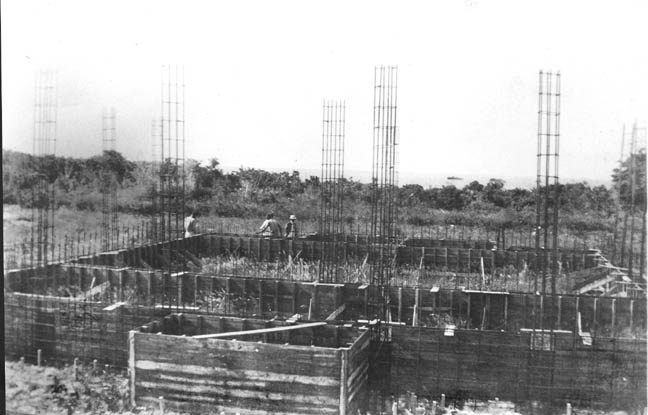 A copy of a June 11, 1937 project status reports indicate at Tavernier the first floor concrete slab had been poured and the forms and steel being placed for the second floor. At Matecumbe the footing excavation has been completed. This was rather sketchy info as there is no second floor as such - the next floor is the roof. I am not certain which school is shown in the photo at the right, but it would be in a state of completion between the schools - Tavernier would have the concrete floor poured and it appears that they are about ready to pour the first floor here. Islamorada probably would not yet have above ground wooden forms or the steel rebar in place. The vertical columns of steel rebar are for the columns to support the upper portion of the building. Now to the MCBPI minutes of August 19, 1937 we find: ".... Mr. Preston Pinder advised that the storm refuge schools would not be ready for the beginning of school in September. The secretary was directed to ascertain through Mr. Pinder if Mr. Sweeting's building which was used last year would be available again this year. and also to inquire of Mr. Clifton Russell the monthly rental on his building...." A month to month contract was made for the Sweeting building. -
1938 -
From
the MCBPI minutes dated
January 8, 1938, we read, "... A letter from Roger L. Albury at
Tavernier requested that black boards, electric plant and pressure pump
be furnished for the storm refuge school at Tavernier. Mr. Albury
stated further that the WPA cannot furnish these things, but would
install them, provided they were furnished by the school board.
Authority for the purchase the black board and pump was granted. The
Secretary was directed to ascertain the possibility of the Florida
Power and Light Company at Tavernier furnishing electricity to the
school...."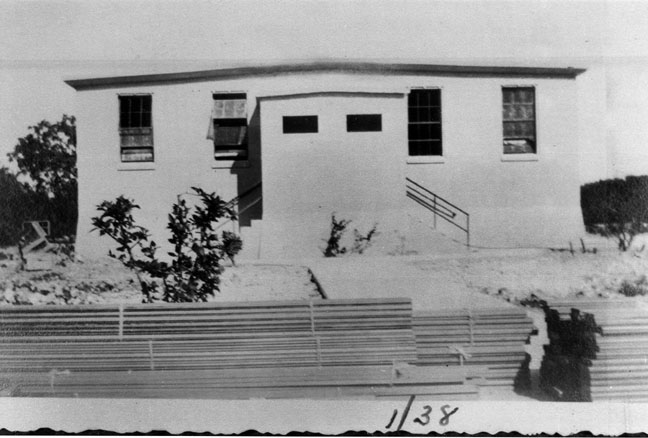 If the photo to the right is dated correctly, judging from the
surrounding landscape it could be the Tavernier school - I am not
certain - and appears to be ready for inside work. I assume the
stack of lumber is to build the center folding room divider. The wooden
accordion folding panels were opened or closed by a mechanical device
traversing the center of the building from front to back thereby making
it possible for two rooms or one larger room. The outside measurements
of the main building area is 45 feet by 45 feet, including the 12 inch
thick walls. The two center windows are for two rest rooms and
the two outside windows are for two very small rooms/offices.
If the photo to the right is dated correctly, judging from the
surrounding landscape it could be the Tavernier school - I am not
certain - and appears to be ready for inside work. I assume the
stack of lumber is to build the center folding room divider. The wooden
accordion folding panels were opened or closed by a mechanical device
traversing the center of the building from front to back thereby making
it possible for two rooms or one larger room. The outside measurements
of the main building area is 45 feet by 45 feet, including the 12 inch
thick walls. The two center windows are for two rest rooms and
the two outside windows are for two very small rooms/offices.Part of a long letter written by C. Marvin Thompson, Timekeeper, dated March 11, 1938, challenging an official order "....which ordered the complete closing of these unfinished Storm Shelters effective 3-18-38...." to Hon. J.. Mark Wilcox, "... If you could find it convenient to visit the sites at Tavernier & Upper Matecumbe and make a personal inspection and investigation we feel that you would then be in position to realize the fairness and sincerity of our claim. It is being planned to propose that the sponsors be required to take over and complete these two buildings, this plan we realize will not meet with success due to the fact that the sponsors do not have the facilities necessary to carry out such a program. The WPA started this program and we feel that they should be required to complete same or give account of their stewardship of the monies appropriated...." The letter was forwarded to Mr. Aubrey Williams of the WPA in Washington, D.C. who responded with a brief history of the project adding, "... the project has been temporarily closed down, with the intention of resuming work as soon as the superintendent can organize a crew of non-relief workers who are willing to work...." [The actual word in the order was "suspended." - JW] The School Board addressed this dilemma in its minutes of March 31, 1938, "...Advices were received from Jerome D. Peterson, WPA Area Supervisor, that the work on the storm refuge houses at Tavernier and Matecumbe has been suspended temporarily, the reason being unsatisfactory progress. The telegram from Robert J. Dill. State, WPA Administrator, gave notice of the temporary suspension of the projects due both to unsatisfactory progress and excessive cost. Mr. Dill gave further information to the effect that the projects could be completed with the present of allotment and further that it would be reported that he had interviewed Mr. Little and received the information that the work on the projects would be resumed on March 38...." Paraphrasing a WPA status report dated May 31, 1938 by Mr. A.J. Little, land fill was being completed at the Tavernier school (This is what makes me curious about the January 1938 date on the above photo as the land fill 'appears' completed.). At Matecumbe, he reports that the roof is finished, wall forms being removed and workers beginning inside work. I do not have documentation of when the schools were accepted by the School Board must less when they opened for students. There is a MCBPI August 4, 1938 agreement to assume liability on two trucks used for hauling marl for filling the Matecumbe school yard and direction to order steel screen frames from L.P. Ireland and Co. of Miami at the price of $201.68 for both schools. In October 1938 the MCBPI still had not hired caretakers for the schools. At one time I was of the opinion that the schools were not accepted and opened in 1938. Having been a part of government operations before, government entities are generally not quick to transfer/accept projects until they are totally completed. Since then I was able to obtain microfilm of the Board minutes available when the Board converted their records to microfilm. In my opinion my copies are more complete; however, I did come across a 1938 entry I believe reflects the difference between the WPA and FERA. Minutes dated July 7, 1838 state: "... A letter from A.J. Little Jr., advised that it would be satisfactory for the Board to use the [concrete] form lumber for the purpose of constructing bleachers, but that it would be necessary that the School Board furnish the WPA with a letter of assurance that the lumber would be only on the school sites and would not fall into the hands of private parties for private use. The offer was accepted and the secretary directed to furnish the letter...." After reviewing the 1938 microfilm, I found no specific mention of the two schools being totally completed, being released by the WPA, being accepted by Monroe County or an entry stating there were being used for school purposes. In May of 1938 I did find approvals of caretakers and janitors being hired. Then in June of 1938 funds were appropriated for two water pressure pumps be furnished the schools. I pre 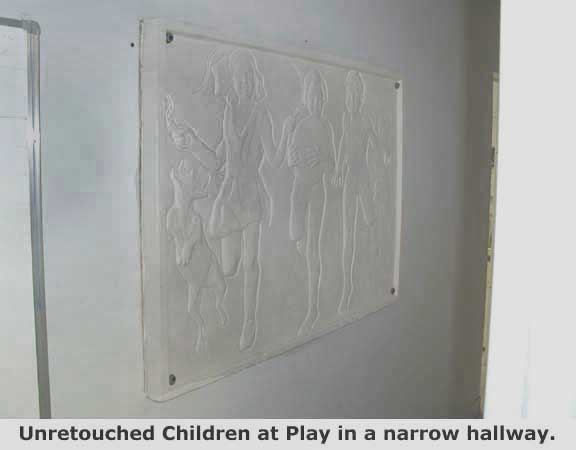 sume, these
were to pump the water from the two cisterns at the rear of the
building to the kitchens and bathroom at the front of the
buildings. sume, these
were to pump the water from the two cisterns at the rear of the
building to the kitchens and bathroom at the front of the
buildings.I feel now confident that school services began in September 1938. In early 1939, two additional students were added to the Tavernier school and additional transportation funds were appropriated. One final comment about the schools when in their original operation. In a separate project, the WPA provided decorations of art for schools. In Monroe County, I have found BAS relief sculptures done by WPA artist Joan van Breemen. The one that I found in the old Tavernier School building in the year 2000 is shown at the right. To visit the web page of WPA Art, Please Click Here.  Following are various photos relating to the two schools. The spaces between the text is necessary to absorb space for the photos. This subject is summarized after these photos. The photo to the right is actually a postcard but is not postmarked; therefore, the date is just a guess. Note the storm shutters and windows. The window screens must have been on the inside. I do not see the flag pole, but it could be to the left of the photo; however, it was very close to front entrance/ 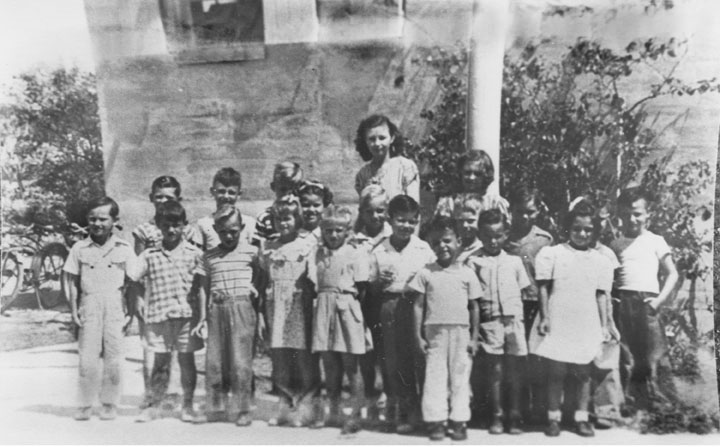 The teacher in the photo to the right is Mrs. Violet Albury from Tavernier. Mrs. Violet normally taught the younger students and Charles "Prof" Albury taught the older students. This photo is thought to be circa 1947. 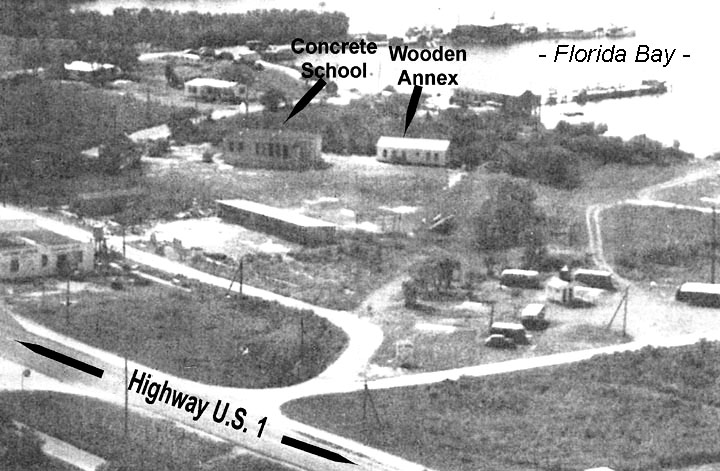 The addition of a wooden annex to the rear of the Tavernier concrete school building is not well documented. This photo of Shirley Faye Albury, daughter of school teacher, Violet Albury, shows a wooden annex building constructed to handle an over-flow of students which occurred in late 1940s. This allowed the student load 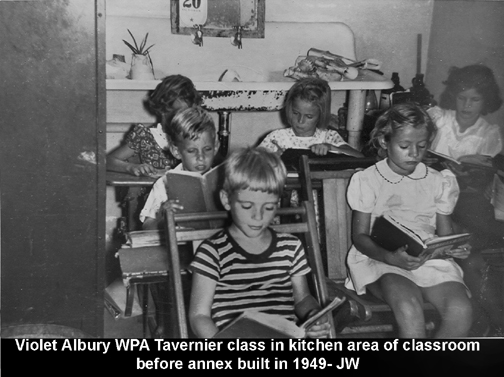 to be divided into three groups. I hear that Mr. Harold Russell taught the middle aged students which met in this one room annex; however, below are several photos that I have relating to the crowed condition of the school. 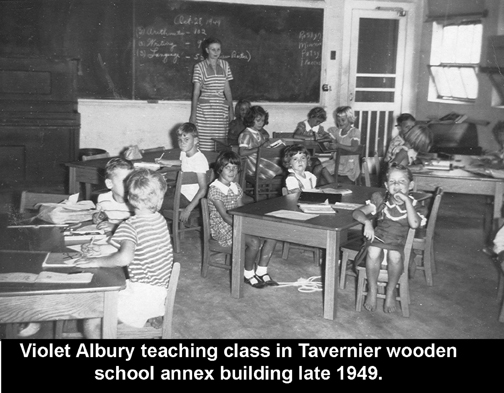 The student load increased at both schools and signaled the construction of a single combined school complex manifested by the opening of the Coral Shores School in 1951. In 1952 Coral Shores was accredited as a high school. The two concrete schools were no longer needed by the School Board. With the opening of the Coral Shores School in 1951, the two school properties were leased by the MCBPI for 99 years to Monroe County. The lease is dated August 1, 1951, signed by Gerald H. Adams and received by Gerald Saunders, Chair of the BOCC. All subsequent negotiations have been done through the county commission. 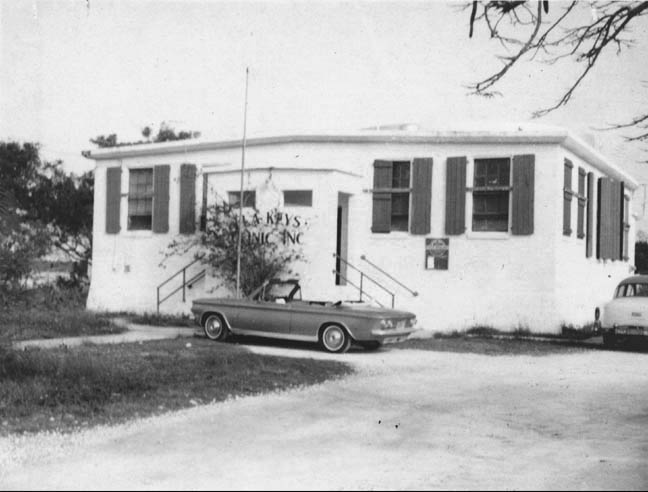 The photo to the right is the Tavernier WPA school building when occupied by Dr. Harvey Cohn. Students were transferred to Coral Shores school beginning in 1951. The Florida Keys Clinic Board obtained the services of Dr. Cohn in 1953. Dr. Cohn moved out shortly after Hurricane Donna in 1960. 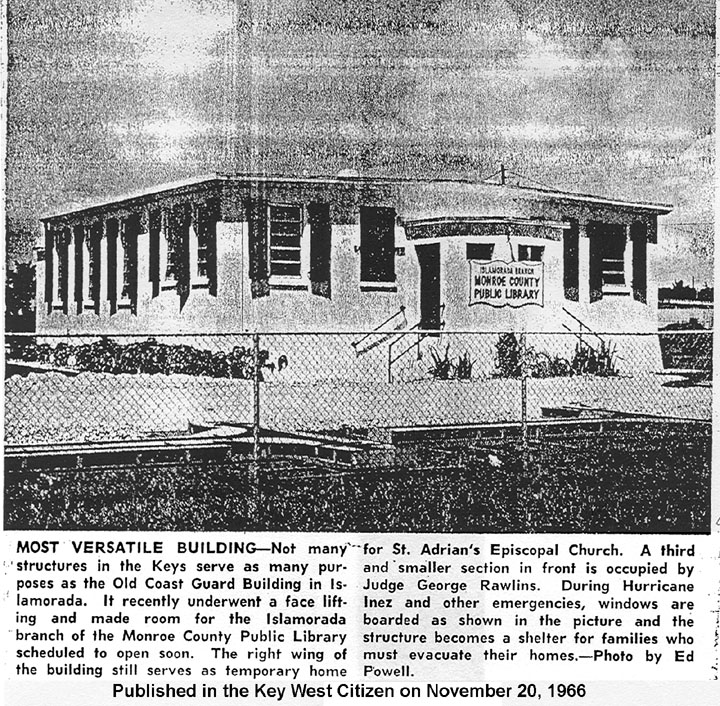 The photo at the right of the Islamorada Library, formerly the Matecumbe School, was published in the Key West Citizen newspaper in November 20, 1966.  To the right is a photo of the former Islamorada hurricane/refuge school taken by the author in 1999. In November 6, 1966 it opened as the Helen Wadley Public Library at MM 81.5, bayside. In 1883, a 2,400 square feet addition was added as the result of a $50,000 fund raiser. In 1999, a 1,600 square-foot poured concrete meeting room was added for $310,000. Before this it was used for many public activities, Some were a youth center, the Baptist Church before it opened its building, etc. Justice of the Peace, Judge Rawlins, had his office there for a while.  To the right is a photo of the former Tavernier hurricane-refuge school taken by the author in 1999. After serving as the Florida Keys Clinic, the inside of the building was modified as the Monroe County Health Department. In the 1990s, a portable building was added at the front as the Environmental Health department. 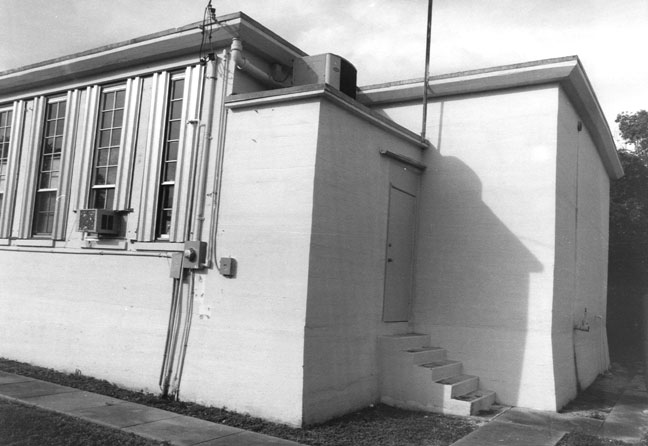 To the right is shown the rear of the former Tavernier hurricane/refuge school and the water cistern is clearly visible at the left. At the lower right slightly in the shadows and protruding from the wall is the water cistern drain pipe. The cistern is functional if an adequate water distribution was installed could be used. -
Epilogue -
Removal of modern elements, retention and restoration of as much of the inside space as possible and the use of the water cistern, the mechanical room divider, original wooden storm shutters, relocate the flag pole, etc. are all items of consideration. In April 2009 none of the above have been done other than considerable money spent on proposed architectural drawings and material selection. Some where in the process, Monroe County took the remaining funds to cover other budget shortages. I do have an aluminum flag pole. I suggest a private not-for-profit organization to organize and see what can be worked out. This building and the Florida Keys Memorial to my knowledge are the only remaining WPA structures in the Upper Keys - both are unique and no other of their kind exist. The Islamorada facility continues to function as a library and has recently had the second addition added to provide more space. Budget reduction proposals have been nipping at this entity, but it is now physically in the incorporated community of the Village of Islamorada. In case you wish to read more of the WPA Art Project in the Keys: Click Here. NOTE: If you entered this page from the link from the "Upper Keys Schools" page, USE THE RETURN ARROW to return the your previous page location. BACK to PAGE ONE |
